Importance of adding a counterweight of hybrid funds to your portfolio

Market context
Last one year has been both eventful and highly volatile for equity markets. Elections in India, US and UK, geo-political tensions in Eastern Europe, Middle East and the Indian sub-continent, global trade uncertainties etc., contributed to volatility in global equity markets, including India (see the chart below). Though the market has rebounded after ceasefire between Israel and Iran, accommodative monetary policies from central banks around the world including the Fed and RBI, as well as continued gold buying by central banks have resulted in a situation where all asset classes are near all time highs. This creates a conundrum for investors – where to invest? At the same time, there are near term headwinds due to geo-political uncertainties especially since the new Administration has assumed office in the United States.
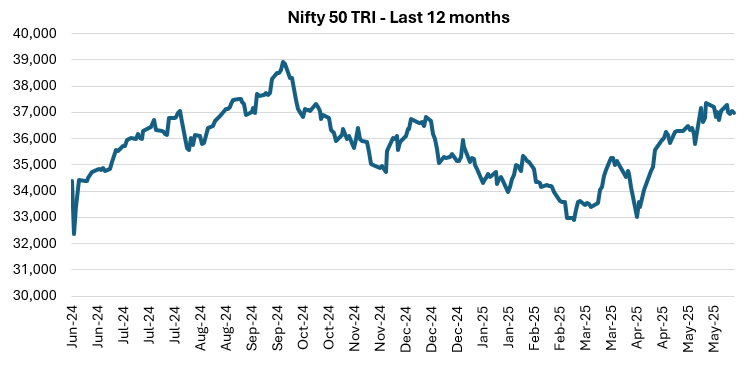
Source: National Stock Exchange, as on 31st May 2025
What should investors do in this situation?
Behavioural biases often cloud judgement and leads investors to make wrong investment decisions. Greed and behaviour are common behavioural biases which induces investors to do the opposite of conventional investing wisdom e.g., buying more when markets are at peak, redeeming when markets crash etc. Market movements often create more confusion in minds of retail investors e.g., market falling suddenly when investors were expecting it to go up, markets rebounding when investors were expecting it to fall etc. – this is what many retail investors experience.
The answer to this confusion is a disciplined investment approach with focus on asset allocation. Different asset classes have different risk / return profiles. They react differently to macro-economic situations and financial market movements. The chart below shows how different asset classes performed in the last 1 year. If you spread your investment across different asset classes, then your investment portfolio will be less affected by what is happening in a particular asset or an asset market segment.
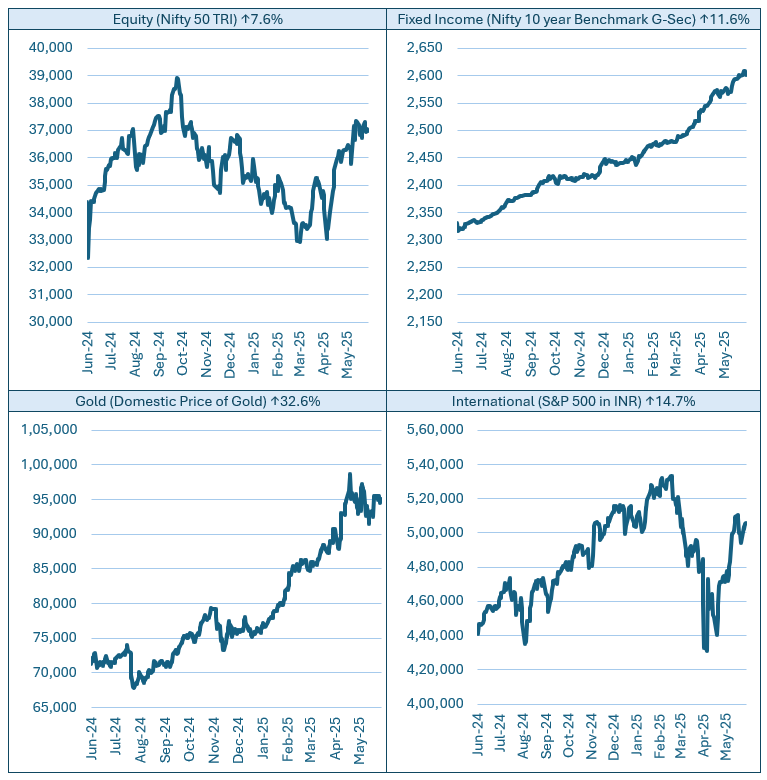
Source: NSE, MCX, Bloomberg, as on 31st May 2025
You can see that different asset classes outperformed each other in different market phases. If you had a mix of asset classes in your investment portfolio, then you could have reduced volatility and added stability to your portfolio. Reduced volatility can curb behavioural biases which harm your financial interests.
Benefits of asset allocation
- Different asset classes have different risk return profiles. The chart below shows 1 year rolling returns of Nifty 50 TRI (equity), Nifty 10-year Benchmark G-Sec Index (debt) and Domestic Price of Gold over the last 20 years. You can see in the chart above, that equity as an asset class is more volatile than gold and fixed income. Fixed income has the lowest volatility among all the three asset classes. Gold is seen a safe haven asset in long term (in the short term even gold can be volatile) since gold is a hedge against inflation.

- Winners rotate across classes. The chart below shows the annual returns from each asset class viz. equity (represented by Nifty 50 TRI), fixed income (represented by Nifty 10-year benchmark G-Sec index), Gold (based on MCX spot prices) and international equity (represented by S&P 500 in INR) over the last 15 years or so. You can see that fixed income has a low correlation with equity and other asset classes. Equity and gold are usually counter cyclical to each other, i.e., gold outperforms when equity underperforms and vice versa. Further, there is a low correlation between different markets. Diversifying your portfolio across asset classes limits downside risk when a particular asset class underperforms.
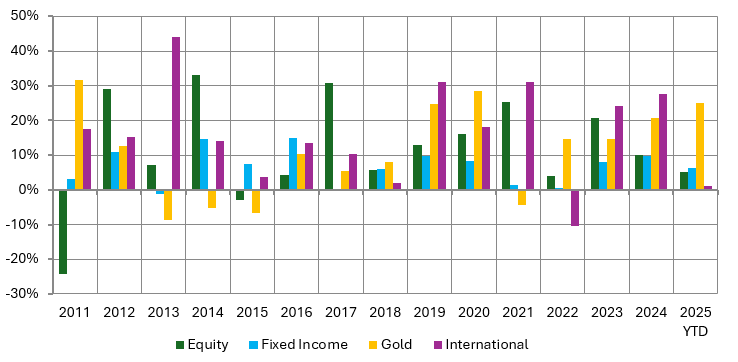
Hybrid funds for asset allocation
Hybrid funds are mutual fund schemes which invest in two or more asset classes e.g., equity, fixed income, gold etc. Different hybrid funds have different asset allocation profiles i.e., percentage allocations to different asset classes.
Types of hybrid funds
There are seven categories of hybrid funds as per SEBI’s mutual fund categorization. The table below shows the various categories of hybrid funds along with their mandated asset allocation limits (as specified by SEBI).
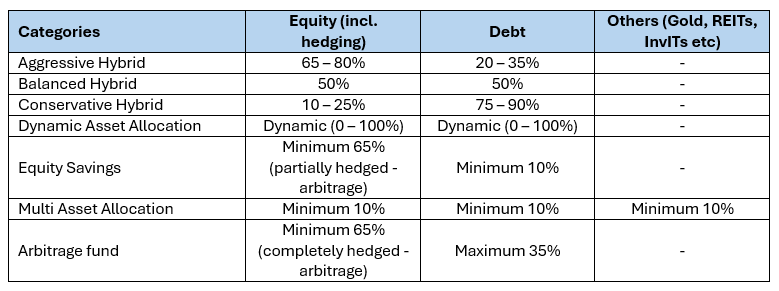
Benefits of hybrid funds
- Hybrid mutual funds offer asset allocation benefits whereby investors can balance risk and return to achieve their financial goals.
- They provide optimal risk/return trade-off. The chart below shows the risk/return characteristic of hybrid funds versus equity and debt funds. With just 2% lower returns compared to equity, a 65% Equity + 35% Debt portfolio provides a 7% reduction in volatility (standard deviation).
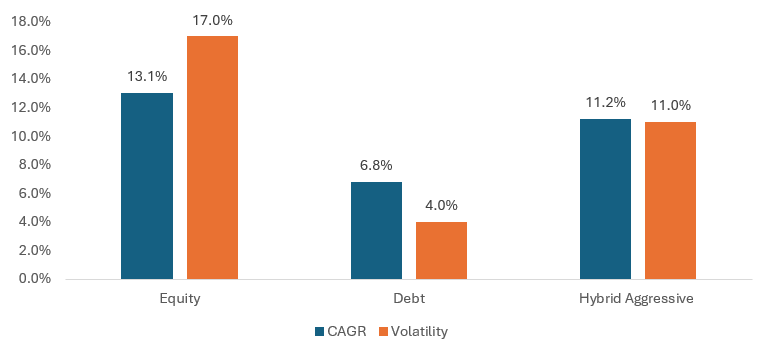
Source: NSE, Advisorkhoj Research. Period: 12th May to 2015 to 12th May 2025. Equity is represented by Nifty 50 TRI, Debt by Nifty 10 year Benchmark G-Sec Index, Hybrid Aggressive is represented by a hypothetical portfolio of 65% Nifty 50 TRI + 35% Nifty 10 year Benchmark G-Sec Index with monthly rebalancing
- Hybrid funds provide asset allocation solutions for investors with different risk appetites. Hybrid funds with higher allocations to equity can be suitable for investors with higher (aggressive) risk appetites, while hybrid funds investing primarily in debt will be suitable for more conservative investors.
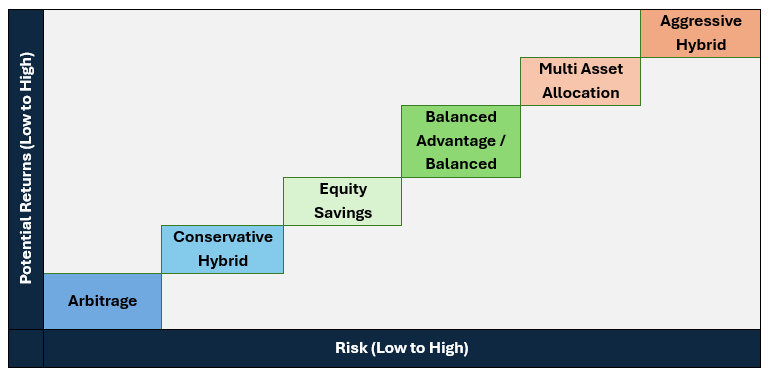
Disclaimer: The graphic above is purely for investment education purposes and does not constitute investment recommendations. Consult your financial advisor before investing
- Hybrid funds provide the benefit of periodic portfolio rebalancing. Rebalancing of assets ensures that the asset allocation of your investments do not deviate from the targeted asset allocation despite market movements. Rebalancing reduces risks and keeps returns reasonable.

Disclaimer: The graphic above is purely for investment education purposes and does not constitute investment recommendations. Consult your financial advisor before investing
- Since hybrid funds are less volatile compared to pure equity funds, they are well suited for SWP. Let us understand the difference between an SWP started in Equity and the other in a Hybrid Aggressive fund as an example. We will choose the year 2008, when the markets went through upheavals due to the Global Financial Crisis.
Scenario 1: A lumpsum investment of Rs 50 lakhs in an Equity fund on 1st April 2008 and a monthly SWP of Rs 30,000 which starts on 1st January 2008 and ends on 1st January 2018.
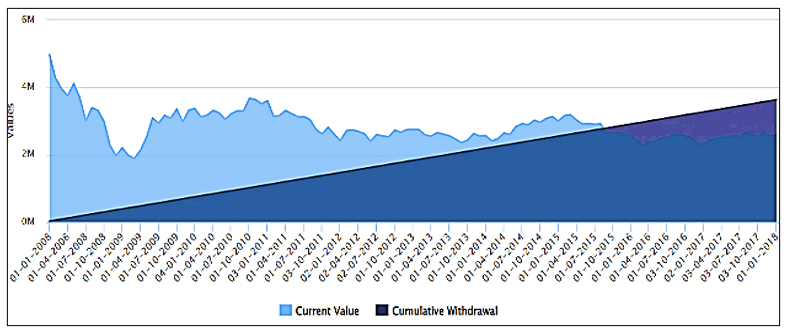
Source: NSE, Advisorkhoj. Results of SWP withdrawal is shown between 1st January 2008 and 1st January 2018. Nifty 50 is taken as proxy for Equity
Scenario 2: A lumpsum investment of Rs 50 lakhs in an Aggressive Hybrid fund on 1st April 2008 and a monthly SWP of Rs 30,000 which starts on 1st January 2008 and ends on 1st January 2018.
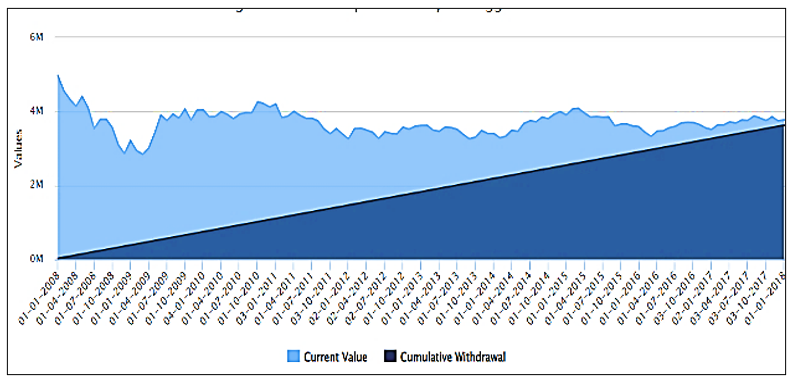
Source: NSE, Advisorkhoj. Results of SWP withdrawal is shown between 1st January 2008 and 1st January 2018. 65% Nifty 50 + 35% Nifty 10 year Benchmark G-Sec with monthly rebalancing is taken as proxy for Hybrid Fund
See the table below that shows the difference in the amount remaining in the corpus after the SWP period of 10 years. (From 1st January 2008 to 1st January 2018)

Source: NSE, Advisorkhoj. Results of SWP withdrawal is shown between 1st January 2008 and 1st January 2018. Hybrid Aggressive category is represented by - 65%Nifty 50 TRI +35% Nifty 10 Year Benchmark G-Sec Index.
The difference in the amount remaining after withdrawing Rs 36.3 lakhs in each scenario shows the risk limiting capacity of Hybrid funds especially in volatile markets which is sure to hit at least once if not more times during the long tenure. - Hybrid funds are also suitable for first time investors who do not have the experience of market volatility.
- Hybrid funds provide tax efficient investment solutions. Long term capital gains (investment holding period of more than 1 year) from funds which have more than 65% gross equity allocation (including hedging) are tax exempt up to Rs 1.25 lakh and taxed at 12.5% thereafter. Long term capital gains (investment holding period of more than 2 year) from funds which have 35% - 65% equity allocations are taxed at 12.5%.
Investors should consult with their financial advisors or mutual fund distributors if hybrid funds are suitable for their investment needs.
Mutual Fund Investments are subject to market risk, read all scheme related documents carefully.
RECOMMENDED READS
LATEST ARTICLES
The information being provided under this section 'Investor Education' is for the sole purpose of creating awareness about Mutual Funds and for their understanding, in general. The views being expressed only constitute opinions and therefore cannot be considered as guidelines, recommendations or as a professional guide for the readers. Before making any investments, the readers are advised to seek independent professional advice, verify the contents in order to arrive at an informed investment decision.
Mutual Fund investments are subject to market risks, read all scheme related documents carefully.
Quick Links
Follow Nippon India MF
More About Nippon India MF
POST A QUERY






